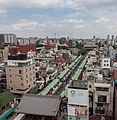Sensō-ji
Sensō-ji ( Japanese 浅 草 寺 ), also Asakusa-dera when the characters are read differently , is a Buddhist temple in Asakusa , Tokyo . Its formal temple name is Kinryūzan ( Japanese 金龍 山 ). It is Tokyo's oldest and most important temple.
history
The history of the temple goes back a long way. According to legend, three fishermen are said to have found a 5 cm tall golden Kannon statue in their net in 628 , which was then venerated. In 645, the priest Shōkai built a temple on the current site. In 942 the temple of Taira no Kinmasa , then Awa-no-kuni no kami, was rebuilt. In 1180 Minamoto no Yoritomo visited the temple on the way from Shimōsa to Kamakura. Yoritomo later brought craftsmen from the temple to Kamakura to build the Tsurugaoka Hachiman-gū . In the reports about it, the field name Asakusa appears for the first time . The temple burned down in 1642, then in the Kanto earthquake and in World War II, but was rebuilt repeatedly, most recently in 1958 using reinforced concrete.
While the Sensō-ji used to belong to the Tendai-shū sect , then to the Kan'ei-ji , it is now the main temple of its own branch, Shōkannon-shū. It is the 13th of the 33 temples on the Bandō junrei pilgrimage route dedicated to the Kannon in the Kantō area. Right next to the main hall is a Shinto shrine , the Asakusa-jinja .
The temple precinct
In the temple precinct you walk through the large gate called "Hōzō-mon", you can rinse your mouth with water as usual and clean yourself with smoke before you reach the main hall of the temple, which is dedicated to the Buddhist deity of grace, Kannon . On the left in the background is the five-story pagoda. In the northwest of the temple area is the small hexagonal hall (rokkakudō). It dates from the Muromachi period and is the oldest surviving building. The stone pillar (mayoi-go shirase sekihyō), where lost children can be dropped off and found by their parents, is not missing on the temple grounds. There is also a garden for contemplation.
The Sensō-ji is visited every year by a large number of tourists from home and abroad. There are many traditional shops and dining rooms in the area, serving traditional dishes such as homemade pasta, sushi and tempura. The entrance to the Nakamise-dori, which leads to the temple, is determined by the Kaminari-mon ("Thunder Gate"), rebuilt in 1960 . On this imposing structure there is a huge paper lantern, which is painted in lively red and blue tones that conjure up associations with thunderclouds and lightning. On both sides of the Nakamise-dori there are small stalls selling souvenirs such as fans, woodblock prints, kimonos, but also toys, T-shirts and cell phone bags. These shops are part of the Sensō-ji tradition.
Note: The Sanja-Matsuri, one of Tokyo's three great Matsuri , takes place on the weekend in mid-May. It is a festival of the Asakusa Shrine, not the temple.
literature
- Tokyo rekishi kyoiku kenkyukai (ed.): Tokyo no rekishi sanpo (jo) . Yamakawa shuppansha, 2001, ISBN 4-634-29130-4 .
Web links
- About Senso-ji. Senso-ji, 2008, accessed March 8, 2013 (English, official site in Japanese, English, Chinese and Korean with history, building names and religious information).
Coordinates: 35 ° 42 '47.55 " N , 139 ° 47' 43.65" O






